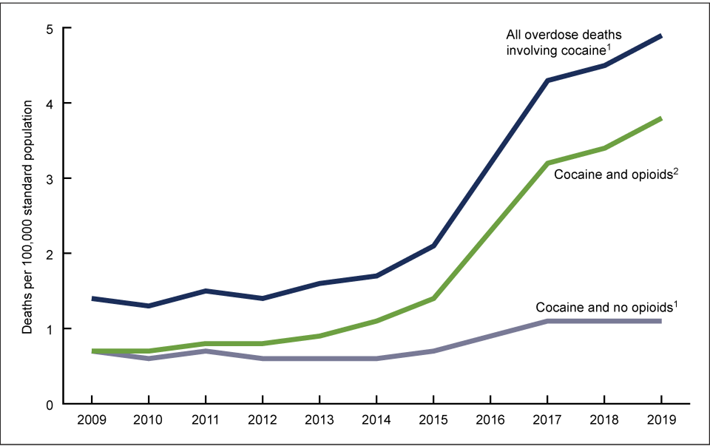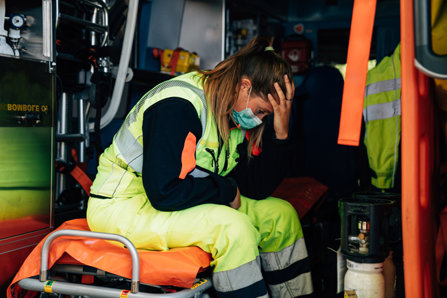A Surge in Cocaine and Meth Deaths are Linked to Opioid Misuse

An April 2021 report by the Centers for Disease Control and Prevention warned residents that cocaine deaths and deaths relating to psychostimulants like meth were rising. The report also warned that there have been increasing instances in which opioids were also present in the addict’s body at the time of death.
The data suggests a grim possibility. Are cheap, potent, and addictive opioids like fentanyl being added to the drug supply without addicts knowing it? Are addicts buying stimulant drugs like cocaine and meth, thinking that is all they are getting, and then taking a hybrid substance that has fentanyl, a depressant, mixed into it?
Experimenting with one mind-altering substance is already quite dangerous. When addicts do this with more than one drug at once, whether they know it or not, they drastically increase their risk for an overdose, for death.
Cocaine and Psychostimulant Deaths on the Rise
According to the CDC Data Brief, from 2009 to 2019, overdose deaths involving both cocaine and opioids increased at a rate much faster than the rate of overdose deaths from cocaine alone. In fact, in 2019, about 76% of overdose deaths involving cocaine also involved an opioid. Some regions, like the Northeast, reported 83% of cocaine-related deaths involving an opioid.
Before 2017, more people died from psychostimulants (usually meth) by itself than those who died from both psychostimulants and opioids. But that pattern reversed after 2017. When all psychostimulant-related deaths are added up from 2017 forward, opioids are present in about 54% of deaths.
“In 2019, three-quarters of the 15,883 drug overdose deaths involving cocaine also involved one or more opioids.”
At the close of the data brief, study authors Hedegaard, Miniño, and Warner summarized the concerning trend by saying: “The findings highlight increases in the co-involvement of opioids in drug overdose deaths involving cocaine and psychostimulants in recent years. In 2019, three-quarters of the 15,883 drug overdose deaths involving cocaine also involved one or more opioids. 53.5% of the 16,167 drug overdose deaths involving psychostimulants in 2019 also involved one or more opioids.”

After reviewing the study findings, Lindsey Vuolo, the vice president of health law and policy with the Center on Addiction in New York City, commented that the CDC Data Brief reveals a concerning trend in America. “The numbers reflect prior trends: Overdose deaths related to cocaine and psychostimulants have been increasing [and] rates of overdoses from synthetic opioids such as fentanyl have also been increasing… Treatment access has not been improving much for people with addiction. That is why we continue to see such high numbers of overdose deaths. People are dying because they can’t get effective care. These deaths are preventable because addiction is treatable.”
Cocaine and Meth Deaths are Going Up; Is Fentanyl the Direct Cause?

The National Institute on Drug Abuse confirms the CDC report. According to NIDA findings, drug overdoses involving cocaine have surged dramatically, from about 3,822 deaths in 1999 to 15,883 deaths in 2019, more than a 400% increase. However, since 2014, NIDA reports that the rising number of cocaine deaths may be because fentanyl has been mixed into the cocaine supply. According to their data, in 2019, only about 5,000 cocaine-related deaths occurred where cocaine was the only drug present. That represents less than one-third of the total cocaine-related deaths that year. The remainder of overdose deaths involved cocaine and opioids.
There’s a similar story with meth. Again drawing from NIDA information, there were only 547 deaths related to meth or other psychostimulants in 1999. But in 2019, 16,167 people died from meth-related causes. That’s almost a 30X increase in fatalities. Also according to NIDA, about 11,000 of the 16,167 people who died from meth-related causes in 2019 died from just meth, whereas another 5,000 or more deaths involved meth and an opioid.
While we cannot prove that the recent phenomenon of opioids being mixed into supplies of cocaine and meth is having a direct cause and effect relationship on the spikes in cocaine and meth deaths (correlation does not alone imply causation), it is almost certain that opioids, primarily fentanyl, are influencing cocaine and meth-related deaths.
Speaking of fentanyl, NIDA has also reported on the sudden spike in fentanyl-related deaths in the United States. In 1999, fewer than 10,000 Americans died from opioid-related causes. But in 2019, 49,860 Americans died from opioids. It is thought that the introduction of fentanyl, particularly illicit fentanyl, into the drug supply has played a huge role in the skyrocketing increase in drug-related deaths.
There is no doubt about it, when a highly potent drug is entered into a drug supply without addicts knowing it, it can have devastating consequences.
Fentanyl – Addictive and Lethal

By now, it is well understood that cocaine and meth-related deaths are on the rise and that addicts put themselves at increased risk when they use more than one drug at once. But to fully understand the severity of this problem, it’s also important to briefly define fentanyl and explain why the drug is so dangerous.
Fentanyl is a powerful synthetic opioid analgesic (pain reliever) similar to morphine but 50 to 100 times more potent. Fentanyl is a Schedule II prescription drug. It is used primarily to treat patients with severe pain, to help patients manage pain after surgery, or to ease pain symptoms for those in palliative care. Fentanyl is so potent that it is sometimes used to treat patients who are physically tolerant to other opioids, meaning other painkillers do not work on them.
By fentanyl’s sheer potency alone, this drug is immensely dangerous and very likely to cause an overdose in those who experiment with it. When added into a drug supply (as in the case of meth or cocaine) without addicts knowing it, it is very easy for them to overdose and even die.
The Need for Treatment – Getting a Loved One Helps Before It’s Too Late
People who use drugs and alcohol and who cannot stop using these substances must seek professional help. An addiction to any mind-altering substance will have harsh, negative consequences that will likely worsen as time passes. Addictions to meth, cocaine, or fentanyl can be devastating.
If you know someone who is using a drug, multiple drugs, or alcohol and who cannot stop using, please get them help as soon as possible.
Sources:
- https://www.cdc.gov/nchs/products/databriefs/db406.htm
- https://www.medicinenet.com/script/main/art.asp?articlekey=254015
- https://www.drugabuse.gov/drug-topics/trends-statistics/overdose-death-rates
- https://www.drugabuse.gov/drug-topics/fentanyl#:~:text=Fentanyl%20is%20a%20powerful%20synthetic,to%20mana


 ®
®